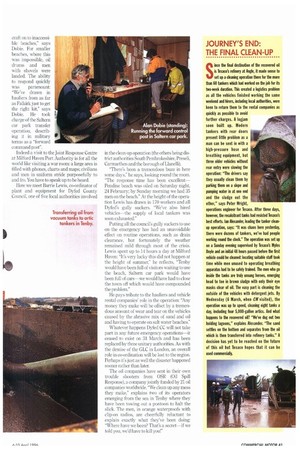JOURNEY'S END: THE FINAL CLEAN-UP
Page 43

If you've noticed an error in this article please click here to report it so we can fix it.
Since the final destination of the recovered oil is Texaco's refinery at Angle, it made sense to set up a cleaning operation there for the more than 60 tankers which had worked on the job for its two-week duration. This created a logistics problem as all the vehicles finished working the same weekend and hirers, including local authorities, were keen to return them to the rental companies as quickly as possible to avoid further charges. A logjam soon built up. Modern tankers with rear doors present little problem as a man can be sent in with a high-pressure hose and breathing equipment, but three older vehicles without rear entry were slowing the operation: "The drivers say they usually clean them by parking them on a slope and pumping water in at one end and the sludge out the other," says Peter Wright, operations engineer for Texaco. After three days, however, the recaicitrant tanks had resisted Texaco's best efforts. Ian Alexander, leading the tanker cleanup operation, says: -It was chaos here yesterday, there were dozens of tankers, we've had people working round the clock." The operation was set up on a Sunday evening supervised by Texaco's Myles Doyle and an initial 48 hours passed before the first vehicle could be cleaned: locating suitable staff took time while men unused to operating breathing apparatus had to be safely trained. The men who go inside the tanks are truly unsung heroes, emerging head to toe in brown sludge with only their eye masks clear of oil. The easy part is cleaning the outside of the vehicles with detergent jets. By Wednesday (6 March, when CM visited), the operation was up to speed, cleaning eight tanks a day, including four 5,000-gallon artics. And what happens to the recovered oil? "We've dug out two holding lagoons," explains Alexander. "The sand settles on the bottom and separates from the oil which is then transferred into refinery tanks." A decision has yet to be reached on the future of this oil hut Texaco hopes that it can be used commercially.
















































































































